

Home On to page 3 of The Allen Register
It is probably important to record the development/evolution of the lines of an Allen boat over the years; this is a start a first attempt using the Allen boats available on the BCN at Hawne Basin. All are boats that have been fitted out by their owners, some not finished, not the smartest of boats but are cherished and used regularly mainly on the BCN and faithfully subscribe to comment's attributed to the Allen's
"There's only one reason to paint a canal boat, and that is to knock the paint off using the damn thing"
"And what's the point of us putting rubbing strakes around a boat if you're going to cover them with fenders".
These boats are used and not polished continually but they look right and their pedigree shines through. All of the boats are different but have the same feel of quality.
What follows are a few photographs of the different features of the boats available that begin to map out the shape and lines of an Allen boat.
Please place the curser over the pictures to see an explanation.
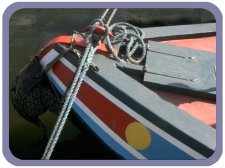
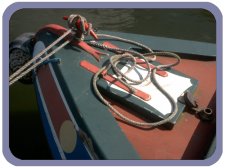
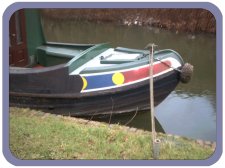
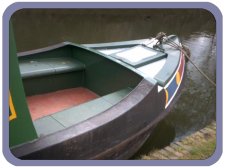
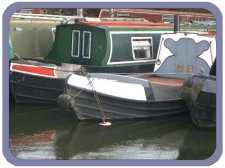
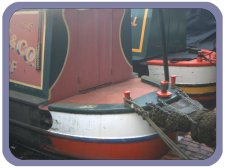

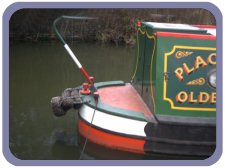
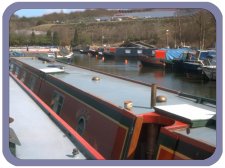
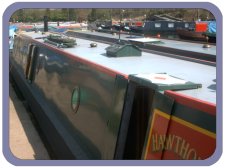
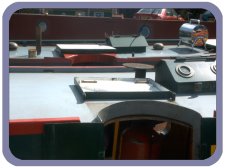
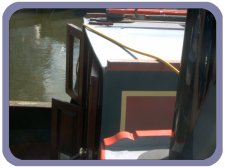
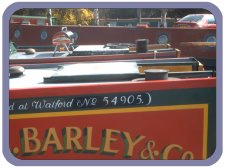
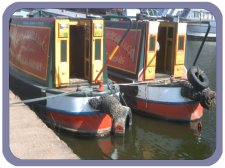
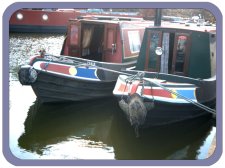
The collecting of the details of every Allen boat built is a difficult one. The Allens never kept a true record of the number of boats they built or worked on, and nobody not even the tax man can give us a list.
The names of boats change as do owners over the years and can result in boats being lost to the register, the one piece of information the BW NUMBER normally does not change. But an added complication occurs if the boat moves off BW waters onto say the Thames and loses its BW number. If the boat returns it is normally given a new number. Couple this with a new owner and we have lost track of the boat.
Older boats from the 1960's have the added problem that many pre date the issuing of BW numbers, so the tracing of older boats for previous owners is further complicated especially when the boat changes its name.
So in an attempt to bring the canal telephone up to date we would like to hear from anyone who wishes to trace an Allen Boat from any era, and from new owners who may have an old lost boat? by visiting:-
Allens Lost Boat List
The BW number if it remains the same gives everybody a chance at tracing boats when they are sold etc. So please when writing or contacting the register please include the BW Number of your boat.
If selling and you know of the register please leave details of group on the boat, so the history of the boat can be carried forward, a good selling point? in todays market
A simple list of boats can be found on this site with a Allen Form attached in the Allen List section: so details of boats can be passed on to us all. Owners details unless requested to do so will not appear on the list.
Allens Boat List
For many people who moored at Valencia Wharf the fitting out of their boat was frequently interrupted by weekend cruises to many of the rallies and boat gatherings around the BCN.
Mooring at the yard was always different; nobody had a specific mooring you just stopped were you could get in. Your boat was frequently moved so someone could get out or work on their boat but nobody seemed to mind.
Many boats went to these events unfinished, painted in grey undercoat some probably staying in this stage for to long. At one rally on the Shroppie about three or four such boats attended and had to leave in the early hours of one Sunday morning to stand any chance of returning to Oldbury. All the boats slipped their moorings and tried quietly to leave without disturbing the rest of the crews. However one member of a boat crew was disturbed and was heard to remark, "Its all right luv it's the Oldbury Navy on manoeuvres and the destroyer escort is just leaving". Hence the label stuck but caused all the owners of the boats in question to get their boats painted properly.
Later when all the boats had been painted annual cruises also used to take place with numerous boats from the yard travelling together. It was always amusing passing fishermen or walkers and recording their reaction. Usually the last boat in the line would met the comment "Alright I give up where is Valencia Wharf" having just seen three or more boats pass, each proudly having sign written on them the name of the yard. Usually telling them where the yard was left them even more confused, Old Main Line canal, Oldbury, West Midlands where's that?
Another reaction as people passed the boat was to comment "That sounds like a nice place" they were right but probably not in the way they thought. On the odd occasion you tried to describe the place to the stranger it usually came out sounding like the description of a scrap yard surrounded by heavy goods vehicles, which on reflection was probably what it did looked like.
No doubt like any owner of an Allen , whilst out cruising you would met some knowledgeable person who would instantly recognize an Allen boat and complement you on your boat. When you informed that person that you moored at the yard you would be asked to remember that person to the Allen's, thus was the fame of the brothers on the cut.
Meeting another Allen boat anywhere on the system usually called for a wave or a chat, but to meet another boat that moored at the yard usually met stopping for a drink.
The Oldbury navy has dispersed all over the system since the yard closed, Valencia Wharf is now the home to another community of boats, I hope they have as much fun as we all did. The spirit of the yard is still alive amongst the members that are still boating, with most of us still looking for a mooring some where on the system that is as good as Valencia Wharf, but I think they broke the mould when they made the Allen's.
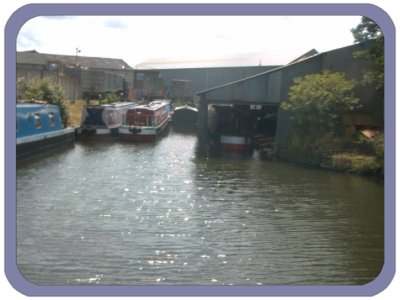
The name Valencia Wharf is known to all owners of Allen Brothers built boats as the yard where their boat was constructed. Placed beside the Old Main Line at Oldbury near Whimsey Bridge, the Allen Boatyard was a seemingly enduring feature until the Allen's Brothers decided to retire and close the yard in 1997. Les Allen had learnt their trade building and repairing the Joey and Cabin boats at Salford Bridge, for Spencer Abbot, but later transferred to Oldbury about 1951, where he traded as Les Allen & Sons. Bob and John Allen assisted their father to build and repair boats in the yard that had previously been used by Thomas & Samuel Element.
Edward Paget Tomlinson's drawing depicts a wooden joey boat on the bank at Valencia Wharf undergoing repair. With the final decline of commercial carrying on the BCN in the 1960's the Allen's turned their skills to building pleasure craft for the growing boating fraternity. During this period they also changed from making boats of wood to boats of steel. Bob and John Allen continued the boatyard business after the death of their father, Les. Valencia Wharf, at this time, comprised two basins. Boats were assembled on the bank placed between the two arms. Part of the site included a covered building where the early stages of construction were carried out and some of the later stages, such as painting. All stores were kept in a wooden shed constructed from boat bottoms, which probably dated from the time Elements had the wharf. When the yard closed this shed was demolished.
Allen's Yard was always a cluttered place where boats under repair and construction lined the banks and a collection of other craft were moored along the canal side. Here was a place on the BCN where time almost stood still whilst all about it was changing. The buildings beside the towpath at Whimsey Bridge were demolished, the Oldbury Loop was filled in and Whimsey Bridge itself was eventually rebuilt as part of the Churchbridge road-widening scheme. Churchbridge widening also caused the demolition of an old mission building, which had a foundation stone with the name Walter Showell (the Langley Brewery owner) inscribed as well of the names of members of the Element family stamped into the brickwork.
The mission building belonged to a different age when the area around the canal had brickworks and collieries at work and the spiritual needs of the workers and miners were looked after by the ministers based there. Whimsey Bridge appears to take its name from Whimsey Colliery that had a number of shafts west of the canal that were linked by tram roads to basins beside the canal, one of which formed part of Valencia Wharf, in later times.
Valencia is a modern name for the wharf, the original spelling was Valentia and it is version that appears on all nineteenth century and early twentieth century maps that show it. The canal side here had a long and changing history. When the BCN was first made through Oldbury in the years 1769 and 1770, the route followed a winding course through the centre of the town. At the spot where Valencia Wharf came to be made the canal crossed a small stream before turning eastwards towards Oldbury. During 1820 the BCN proprietors had the Old Main Line straightened at this point driving a new line of canal from the aqueduct through to the Brades relegating the part of the old line through Oldbury to loop status. The junction became known as Oldbury Old Turn (East End).
There were ultimately five basins opposite the junction with the Oldbury Loop. The first pair was established during the early part of the nineteenth century to serve mines that raised both coal and ironstone. The others were made later to serve various brickworks and by 1857 all five had been established. The first basin of the group (if seen from Seven Stars Bridge) was gradually extended during the 1860's and early 1870's. It passed under Park Street and terminated near the shafts of the old Whimsey Colliery that had been renamed Valentia Colliery. Mineral statistics for the period record Whitehouse & Smith as owners of the mine.
The extended basin became known as both the Valentia Arm and Churchbridge Branch. In addition to Valentia Colliery, this branch also served Churchbridge brickworks and Highfield Colliery.
Chance & Hunt chemical manufacturers also established a boat dock beside the Valentia Arm where they maintained their fleet of boats. A Belfast Roofed shed covered one part of the yard, which bordered the south side of the arm near the junction with the Old Main Line. The once independent chemical manufacturing firms of Chance Brothers (Oldbury) and Hunts & Sons (Wednesbury) had combined in 1898 to form Chance & Hunt. Part of the Chance & Hunt fleet comprised craft specially adapted for the carriage of gas water or tar water from the gas works to their chemical works where it was processed. Other more conventional craft carried muriatic and sulphuring acid in carboys to canal side metal works and rolling mills, where they were used to clean ferrous and non-ferrous metals following annealing. Chance & Hunt was also an early user of motor tugs on the BCN. They had a pair of tugs called the Hector and Stentor. Walker Brothers, of Rickmansworth completed the first of the pair in 1916.
Much of the land around Valentia Wharf was later owned by ICI, who took over the chemical interests of Chance & Hunt, and then Joseph Holloway. Elements leased Valentia Wharf from ICI and sub let the wharf to Les Allen & Sons. Following colliery and brickyard closures, the Valentia Arm was eventually filled in throughout its entire length. It was the next two basins, which became part of Allen's Boatyard and the modern Valencia Wharf. The first of the Allen basins had been constructed to serve the needs of Radnalfield (sometimes called Radnall Field) Brickworks and Colliery, which at one time was owned by Wood & Ivery. The mine, established first, covered some 30 acres of mineral property that had seams of Brooch, Heathen, New Mine and Thick Coal as well as Gubbin and New Mine Ironstone. The surface plant included a steam winding engine, pumping engine, pit head gear, but little else. 600 yards of horse drawn tramway linked the pithead with the canal basin wharf, where the different grade s of coal and ironstone were sorted into boats by the loaders. The brickwork's was constructed after 1876 to work a layer of good quality surface clay. After the brickyard opened the tramway was used to bring bricks down to the wharf for loading into boats.
The second of the Allen Basins, and the third of the group, served the glassworks of W.E Chance. Known as the Oldbury Glassworks, this works made it their speciality to produce glass lampshades. Basin No.4 served the Churchbridge Tube Works that belonged to the firm Accles & Pollock. Accles had previously been involved with ammunition, cycle and motorcar making at the Holford Mills, Witton, but when this business failed, in 1901, had transferred to the Churchbridge Works. Accles & Pollock were later to enlarge their business through the construction of the Paddock Tube Works, on former brickyard land north of Whimsey Bridge. J & S Tonks used basin No.5 as a coal wharf. These Birmingham based coal merchants carried coal to Paddock Tube Works from the Cannock Chase Collieries.
Beyond the five basins was Park Hall Wharf that served Morris's Brickworks, a Hay Wharf and finally Whimsey Bridge. The firm of T & S Element still have their road haulage depot at Whimsey Bridge. Elements, who ceased canal carrying during the 1960's, once had several canal side wharves in the Oldbury area. Their stables at Whimsey Bridge were latterly used by Caggy Stevens, but have now been demolished.
It seems that every inch of the canal side around Whimsey Bridge had some canal function. Adaptation was the theme of many BCN wharves and basins that ensured their longevity. Thus it was that mine wharves were adapted for other purposes. Boatbuilding was the last canal related trade carried on here.
Why the name changed from Valentia to Valencia may have been the result of someone seeking to form a link with the Spanish City. This City and Region has no obvious association with Oldbury, but the original name Valentia appears to have a more logical connection with Ireland. Irish labourers frequently found employment in Black Country mines. When the mine owners christened their colliery, Valentia, it may well have been done to remember Valentia on the coast of Southern Ireland. The bleak and windswept Irish Valentia coastline has more similarity with industrial Oldbury than the sun drenched orange groves of Spanish Valencia.
Back to page 1 of The Allen Register On to page 3 of The Allen Register